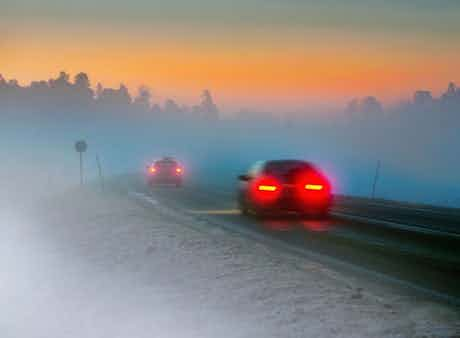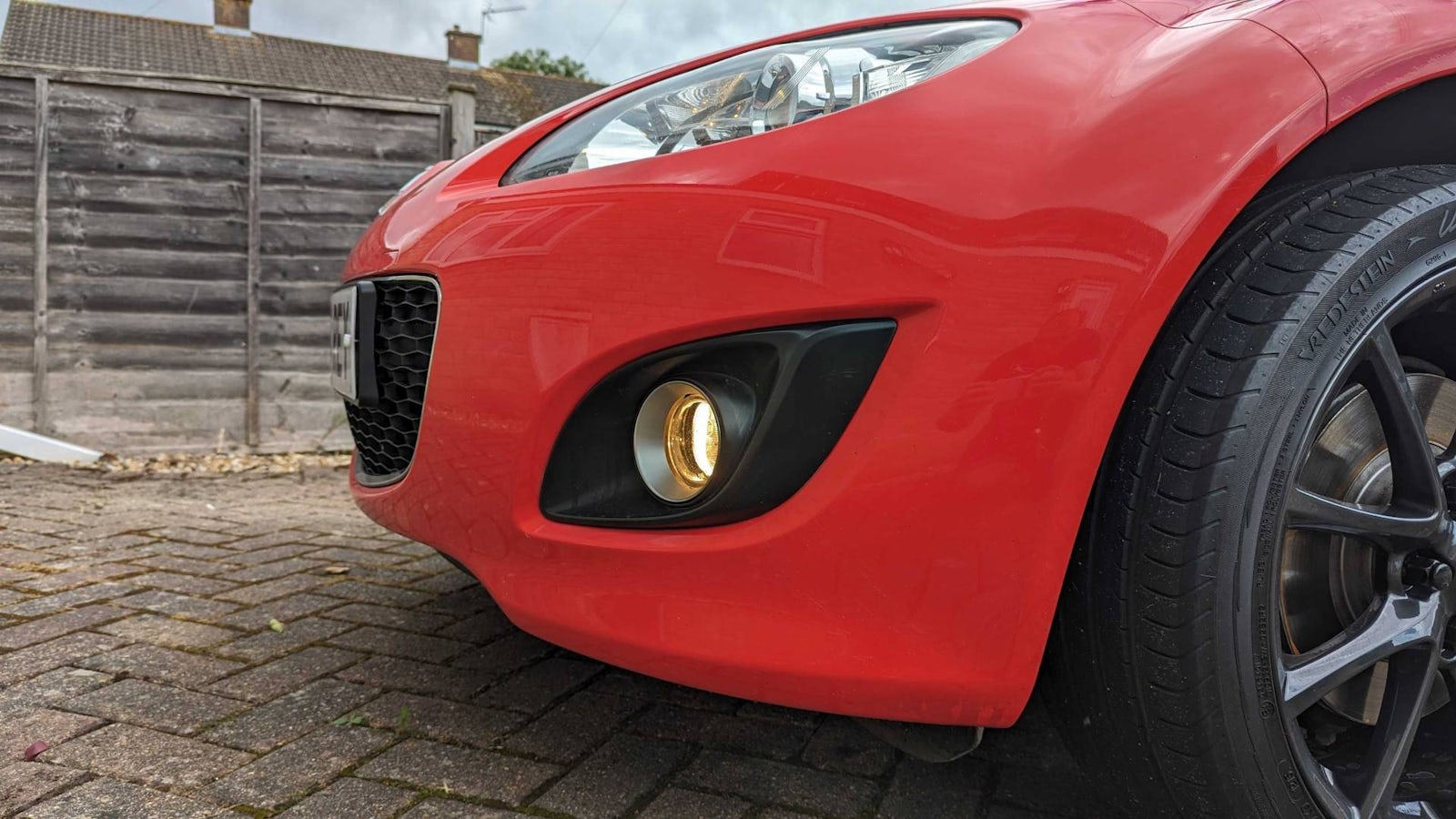What are fog lights and when should you use them?
June 14, 2024 by David Motton

The clue is in the name – fog lights are designed to aid visibility in, well, fog. That much is obvious, but there is still some confusion surrounding when and how they should be used.
Aside from fog, fog lights are there to aid the driver in several low visibility conditions where the standard head and taillights aren’t powerful enough to keep you seen and safe.
We’re going to run through everything you need to know about fog lights, from when and how to use them, to the laws regulating their usage and placement.
Fog light checklist
- At least one rear fog light must be fitted by law
- Front fog lights are optional
- Fog lights must only be used in adverse visibility
- You must not use fog lights when the weather is clear
What do fog lights do?
Fog lights are designed to aid visibility when bad weather conditions reduce your ability to see the road ahead. Front fog lights can cut through mist, fog, rain or even dust as they are mounted lower down than headlights in the front of the car.
Rear fog lights use very bright bulbs to cut through mist and fog to alert other road users of your presence.
Where are the fog lights on a car?
Front fog lights tend to be mounted low down, below the headlights. They illuminate the road directly in front of the vehicle. It is not a legal requirement to have front fog lights, and many manufacturers don’t offer them on their base models, reserving them for higher trims.

Rear fog lights are integrated into the rear light cluster and shine directly rearwards, their job being to alert the vehicle behind you to your presence when visibility is poor. Having at least one rear fog lamp is a legal requirement in the UK, and it must be fitted to the centre or offside rear of a vehicle.
Daytime running lights (DRL) have been a legal requirement in the UK since 2011, however, these are not the same as fog lights and do not aid visibility in inclement weather conditions. They are always on and are meant to make your car more visible rather than provide extra illumination.
What are fog light symbols?
Cars use standard symbols for front and rear fog lights. You’ll see them on light switches, and they will illuminate on the dash when lights are on. In some modern cars such as Teslas the symbols will appear on the infotainment screen rather than the display in front of the driver or on physical switches, and you may need to go through a couple of on-screen menus to access them.
Front fog light symbol
The front fog light symbol shows a lamp pointing to the left. In front of the lamp is a wavy line with some diagonal lines cutting across it representing the light from the lamp.

Rear fog light symbol
The rear fog light symbol points to the right. It also has a wavy line to represent fog with diagonal straight lines running through it.
When to use fog lights
Fog lights are useful when your visibility is decreased such as when it snows or there is thick fog or mist covering the road ahead. They can also help when there is heavy spray on the motorway.
Using your high beams in these conditions can actually reduce your visibility as the bright light reflects off the fog or mist, making it even harder to see ahead.
The Highway Code states that you must not use front or rear fog lights unless visibility is seriously reduced. Using this terminology means that this is a requirement and not a recommendation.
This is because incorrect use of fog lights can dazzle road users, while rear fog lights can obscure your brake lights. The general rule is that you should only use them when you cannot see more than 100 metres ahead. The Highway Code also states that you must switch both front and rear fog lights off when visibility improves.
Front fog lights can help you to see the road ahead when visibility is poor. Just as importantly, they make it easier for traffic coming the other way to spot you. The same goes for vehicles waiting to pull out from a junction up ahead. They help you to see and be seen.
Rear fog lights should always be switched on whenever visibility is poor, they are there to alert other road users of your presence.
How do I turn my fog lights on?
Depending on the make and model of your car, there are a number of ways to turn on your fog lights. There will either be a separate button on the dashboard or a function on your indicator stalk which will allow you to control the fog lights.
Some cars have a rotary knob on the dashboard which can be pulled or pushed to activate the fog lights, others will have buttons next to this knob which will accomplish the same thing.

Some high-tech modern cars have very few physical buttons, with almost all functions controlled through a touchscreen. In these models it can be less obvious how to turn on your fog lights. You’ll probably need to go through a menu or two on the touchscreen.
Make sure you know how to turn on the fog lights so there’s no need for any head-scratching the first time you drive the car in poor visibility.
How do I know my fog lights are on?
Most vehicles will have a symbol that illuminates on the dashboard or driver display to show that the fog lights are on – just like with the head lights.
The symbol for the front fog lights (if fitted) is an oval-shaped lamp with three diagonal lines intersected with a wavy vertical line to the left of it.
The symbol for the rear fog lights is an oval-shaped lamp with three horizontal lines bisected by a wavy vertical line on its right.
So many modern cars have automatic headlights that switch on and off without the driver needing to do anything. That’s not the case with fog lights – it’s up to the driver to decide if they are needed or not.
When should I turn my fog lights off?
The Highway Code states drivers must switch the fog lights off when visibility improves. Leaving the front ones on may dazzle other drivers ahead, while the rear fog light (or lights) can obscure the brake lights. Neither the front nor rear fog lights may be left on when the vehicle is parked. You may get fined for incorrectly using your fog lights.
Fog light FAQs
Do all cars have fog lights?
Yes, it’s a legal requirement in the UK. Any car will have at least one rear fog light, fitted to the centre or the offside rear of the vehicle. Front fog lights don’t have to be fitted. Car makers may fit them to higher-spec models, or they may be available as an optional extra. Generally, they are mounted low down on the front of the car, beneath the headlights.
When to use rear fog lights?
Use rear fog lights when visibility is bad. How bad is bad? The Highway Code advises you should only use rear fog lights when visibility drops below 100 metres.
Why are vehicles fitted with rear fog lights?
Because in very thick fog, a car’s standard rear lights can be tricky to see. Fog lights are brighter to cut through the gloom. That way any car or vehicle approaching your car from behind will spot you in good time.
When visibility is bad, rear fog lights help other vehicles to notice your car sooner than they otherwise would. These lights improve safety when driving in poor visibility.
Why is it dangerous to leave fog lights on?
Because fog lights are so bright, they can dazzle other road users when visibility is good. Some drivers turn on fog lights in the rain or a light mist. This creates glare and can distract other drivers.
At night in clear visibility, fog lights are so bright they interfere with other drivers’ night vision, making visibility worse, not better.
Bright rear fog lights can also make it harder for other road users to see your brake lights clearly, increasing the risk of a collision. Save fog lights for when visibility drops to below 100 metres.
Can I be fined for having my fog lights on?
Yes. The Road Vehicles Lighting Regulations 1989 prohibits the use of fog lights when visibility is not reduced or when a vehicle is parked. So, if you use them when they are not needed you are risking a fine.
Car Change? Carwow!
Looking for a new set of wheels? With Carwow you can sell your car quickly and for a fair price – as well as find great offers on your next one. Whether you’re looking to buy a car brand new, are after something used or you want to explore car leasing options, Carwow is your one stop shop for new car deals.















